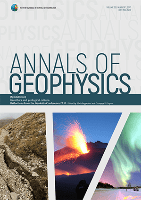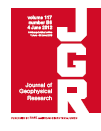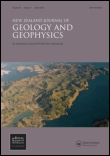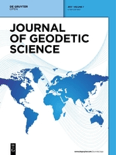
Acta Geodaetica et Geophysica
Scope & Guideline
Advancing Knowledge in Geodesy and Geophysics
Introduction
Aims and Scopes
- Geodetic Measurements and Techniques:
The journal publishes research on various geodetic techniques, including GNSS, leveling, and gravimetry, to enhance the accuracy and reliability of geodetic measurements. - Geophysical Exploration and Analysis:
It covers studies on geophysical methods such as seismic, magnetic, and electrical techniques for subsurface exploration and resource management. - Environmental and Geological Changes Monitoring:
Research on monitoring and analyzing environmental changes, including landslides, groundwater fluctuations, and seismic activities, is a core focus area. - Data Processing and Modeling:
The journal emphasizes advancements in data processing techniques, modeling approaches, and algorithms to improve the interpretation of geodetic and geophysical data. - Machine Learning Applications:
There is a growing interest in applying machine learning methodologies to geosciences, enhancing data analysis, pattern recognition, and predictive modeling.
Trending and Emerging
- Machine Learning and AI in Geosciences:
There is a notable increase in studies applying machine learning and artificial intelligence for data analysis, predictive modeling, and enhancing geophysical interpretations. - Integrated Remote Sensing Techniques:
The integration of various remote sensing methodologies, including satellite imagery and airborne geophysics, is becoming a prominent theme, particularly for environmental monitoring. - Hydrogeological Studies and Groundwater Management:
Research focusing on groundwater resources, including mapping, modeling, and sustainable management practices, is increasingly featured in recent publications. - Seismic Risk Assessment and Mitigation:
With growing concerns about seismic hazards, studies related to seismic risk assessment, monitoring, and mitigation strategies are becoming more prevalent. - Geoinformatics and Spatial Analysis:
The application of geoinformatics and advanced spatial analysis techniques to address complex geospatial problems is gaining attention and is reflected in the journal's recent outputs.
Declining or Waning
- Traditional Geophysical Methods:
Research that relies solely on traditional geophysical methods, such as basic seismic and magnetic surveys without integrating modern technology or data analytics, has seen a decline. - Basic Geological Surveys:
Papers focused exclusively on basic geological surveys without advanced analytical techniques or significant new insights into geological formations are becoming less frequent. - Single-Dimensional Modeling Approaches:
The use of simplistic, single-dimensional models for geophysical data interpretation is waning, as more complex, multi-dimensional approaches gain traction. - Static Data Analysis:
Research primarily centered around static data analysis without the incorporation of temporal dynamics or real-time monitoring techniques is gradually decreasing.
Similar Journals

Quaderni di Geofisica
Exploring the Depths of Geophysical PhenomenaQuaderni di Geofisica is a distinguished academic journal published by the IST NAZIONALE GEOFISICA & VULCANOLOGIA-INGV in Italy, focusing on pivotal areas within the fields of geophysics, geology, and computer applications in Earth sciences. Since its inception, this journal has served as a vital platform for the dissemination of innovative research and methodologies, advancing our understanding of geophysical phenomena and their implications. The journal spans various converged years from 2007 to 2019 and 2021 to 2024, allowing for a comprehensive examination of contemporary developments in the field. Despite being categorized in Q3 and Q4 quartiles by Scopus, it plays a critical role in bridging the gap between theory and practice for researchers, professionals, and students alike. The journal's commitment to fostering scholarly communication is underscored by its strategic focus on multidisciplinary studies, making it an essential resource for those engaged in Earth sciences research. Readers can access the journal's content through institutional libraries or by direct request, ensuring a broad reach and ongoing contribution to the global scientific community.

Reports on Geodesy and Geoinformatics
Transforming geospatial research into actionable knowledge.Reports on Geodesy and Geoinformatics, an esteemed scholarly journal published by SCIENDO, stands as a vital platform in the field of geodesy, geoinformatics, and related sciences. With an ISSN of 2391-8365 and E-ISSN 2391-8152, this open-access journal has been providing free access to impactful research and advancements in the domain since 2013. Located in Warsaw, Poland, at Bogumila Zuga 32A, Mazovia 01-811, it aims to disseminate high-quality research articles, case studies, and reviews that are crucial for academics, industry professionals, and students alike. The journal's commitment to promoting innovative methodologies and technological advancements reinforces its position as an important resource for fostering collaboration and knowledge sharing across global communities in geodesy and geoinformatics.

Applied Geophysics
Transforming Geophysical Knowledge into Practical SolutionsApplied Geophysics is a premier journal dedicated to the interdisciplinary study of geophysical processes and their applications across various domains, published by SPRINGER. With an ISSN of 1672-7975 and an E-ISSN of 1993-0658, this journal serves as a pivotal platform for researchers, professionals, and students to share their latest findings and insights in the field of geophysics. Operating from China, the journal has established itself within the Q3 quartile in Geophysics as of 2023, reflecting its commitment to high-quality research, even as it ranks #105 out of 165 in the Earth and Planetary Sciences category, placing it in the 36th percentile on Scopus rankings. This makes it an essential resource for advancing knowledge in geophysical methodologies and applications. While it operates in a traditional subscription model, its relevance and timeliness ensure it remains a crucial outlet for emerging scientific discussions. The journal particularly encourages the integration of practical applications with theoretical frameworks, fostering innovation in areas such as environmental geophysics, resource exploration, and hazard assessment.

ANNALS OF GEOPHYSICS
Championing Open Access to Transform Geophysical ResearchANNALS OF GEOPHYSICS is a prestigious open access journal dedicated to the advancement and dissemination of research in the field of geophysics. Published by the IST NAZIONALE DI GEOFISICA E VULCANOLOGIA in Italy, this journal has embraced open access since its inception in 1948, promoting wide accessibility to cutting-edge research. With an impressive Scopus ranking, placing it in the 52nd percentile within Earth and Planetary Sciences for the category of Geophysics, the journal serves as a vital platform for scholars, researchers, and practitioners seeking to explore the intricate phenomena of our planet. Covering a diverse range of topics in the geophysical community, the ANNALS OF GEOPHYSICS invites contributions that push the boundaries of our knowledge and understanding of geophysical processes, aiding in the development of innovative solutions to urgent environmental challenges. Published continuously from 2002 to 2024, the journal’s commitment to quality and rigor is reflected in its Q3 quartile ranking for 2023, making it a notable resource for the academic community.

JOURNAL OF GEOPHYSICAL RESEARCH-SOLID EARTH
Transforming Insights into Earth and Planetary SciencesJOURNAL OF GEOPHYSICAL RESEARCH-SOLID EARTH is a prestigious journal published by the American Geophysical Union, dedicated to advancing the study of solid Earth sciences. With an ISSN of 2169-9313 and E-ISSN of 2169-9356, it serves as a leading platform for rigorous research findings and innovative advancements within the fields of Earth and Planetary Sciences, Geochemistry and Petrology, Geophysics, and Space and Planetary Science. The journal has achieved an impressive Q1 quartile ranking across these categories, reflecting its high impact in the academic community and underscoring its role in influencing scientific discourse. Notably, it holds an esteemed position in Scopus, ranking 15th among 159 journals in Earth and Planetary Sciences (miscellaneous) as well as within the top 20 in several other geophysical domains. Researchers and practitioners are encouraged to contribute their work to this esteemed journal, which publishes comprehensive articles from 1979 to the present, thus providing a crucial repository of knowledge for those engaged in solid Earth research. Although it does not currently offer Open Access options, the journal's prestigious reputation ensures its articles reach a wide audience of academics, professionals, and students alike, fueling a deeper understanding of our planet's processes and challenges.

Journal of Advances in Modeling Earth Systems
Connecting Researchers to the Pulse of Planetary Science.Journal of Advances in Modeling Earth Systems, published by the American Geophysical Union, is a foremost open access journal that has been contributing to the fields of Earth and Planetary Sciences, Environmental Chemistry, and Global and Planetary Change since its inception in 2009. With a remarkable impact factor and consistently maintained Q1 category rankings across several key disciplines, this journal stands out as a leading platform for disseminating innovative research and modeling advancements critical to understanding Earth systems. It is ranked in the top 5% of Earth and Planetary Sciences and Environmental Chemistry, emphasizing the high caliber of work published within its pages. The journal engages a diverse audience, including researchers, professionals, and students, by providing a comprehensive repository of cutting-edge studies and findings that are openly accessible to the global scientific community. With its headquarters in the United States and converging research from 2011 to 2024, the Journal of Advances in Modeling Earth Systems remains an essential resource for those seeking to explore and advance the frontiers of environmental science and modeling techniques.

Geofizika
Connecting Researchers to the Core of GeophysicsGeofizika, an esteemed journal published by the Andrija Mohorovičić Geophysical Institute at the University of Zagreb, presents a significant platform for research in the fields of geophysics and Earth sciences. With an Open Access model established since 1984, this journal ensures that scientific knowledge is accessible to a broad audience, encouraging collaborations and the free exchange of ideas. Geofizika has steadily evolved through its converging years from 1989 to 1999 and has been active from 2003 to the present, reflecting its commitment to advancing geophysical research. The journal has been recognized for its contributions to Earth and Planetary Sciences and has acquired respectable ranks in various categories; notably, it holds a Q4 status in Geophysics as of 2023. Researchers, professionals, and students will find Geofizika a valuable resource for the latest discoveries and methodologies in geophysics, supporting the academic community in expanding the frontiers of knowledge in these vital scientific domains.

Near Surface Geophysics
Exploring the Depths of Innovation in GeophysicsNear Surface Geophysics is a prominent journal published by WILEY, dedicated to the field of geophysics, particularly focusing on the innovative methodologies and techniques for subsurface exploration. With its ISSN 1569-4445 and E-ISSN 1873-0604, the journal has established itself as a reputable source of valuable research since its inception in 2003. The journal is currently ranked in the Q2 category within geophysics, reflecting its significant contribution to the discipline, and boasts a commendable Scopus ranking, placing it at #57 out of 165 in Earth and Planetary Sciences. Aimed at researchers, professionals, and students alike, Near Surface Geophysics provides a platform for disseminating high-quality research that enhances our understanding of subsurface processes and applications, making it an essential resource for anyone involved in geophysical studies. Although it does not currently offer open access options, its dedication to advancing geophysical science continues to resonate strongly within the academic community.

NEW ZEALAND JOURNAL OF GEOLOGY AND GEOPHYSICS
Illuminating the Complexities of Our Planet's Processes.NEW ZEALAND JOURNAL OF GEOLOGY AND GEOPHYSICS, published by Taylor & Francis Ltd, stands as a prominent forum dedicated to the interdisciplinary exploration of geological and geophysical phenomena. With an impact factor that situates this journal in the prestigious Q1 category across key subjects—namely Earth and Planetary Sciences, Geology, and Geophysics—it is a critical resource for researchers, professionals, and students alike. The journal has been operational since 1958 and continues to contribute valuable insights into the complexities of the Earth's processes. Although it does not currently offer Open Access options, its broad readership benefits from an extensive archive of high-quality research findings that span from 1958 to 2024. Located in the United Kingdom, the journal remains a pivotal player in advancing the understanding of Earth's systems, making significant contributions to both academic inquiry and practical applications in the field.

Journal of Geodetic Science
Transforming Geophysical Insights into Practical Solutions.Journal of Geodetic Science, published by DE GRUYTER POLAND SP Z O O, is a premier academic journal dedicated to the advancement of the field of geodesy and its interconnected disciplines. As an Open Access journal since 2011, it ensures that high-quality research is readily accessible to researchers, practitioners, and students alike. With an ISSN of 2081-9919 and an E-ISSN of 2081-9943, this journal plays a critical role in disseminating innovative findings related to geophysical phenomena, applied mathematics, and Earth sciences. Currently ranked in the Q3 category across multiple disciplines such as Applied Mathematics and Geophysics, the journal's Scopus rankings reflect its growing impact in the academic community, with noteworthy positions in Earth and Planetary Sciences and Astronomy. The Journal of Geodetic Science not only fosters cutting-edge research but also promotes interdisciplinary collaboration, ultimately contributing to advancements in understanding our planet and improving geodetic applications.